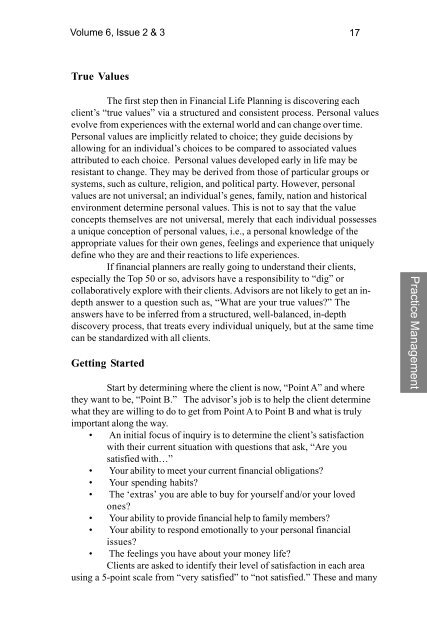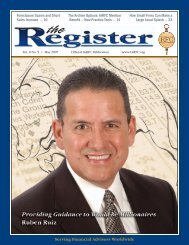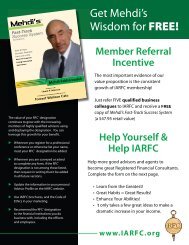3433-vol. 6 issue 2-3.pmd - iarfc
3433-vol. 6 issue 2-3.pmd - iarfc
3433-vol. 6 issue 2-3.pmd - iarfc
Create successful ePaper yourself
Turn your PDF publications into a flip-book with our unique Google optimized e-Paper software.
Volume 6, Issue 2 & 3 17<br />
True Values<br />
The first step then in Financial Life Planning is discovering each<br />
client’s “true values” via a structured and consistent process. Personal values<br />
e<strong>vol</strong>ve from experiences with the external world and can change over time.<br />
Personal values are implicitly related to choice; they guide decisions by<br />
allowing for an individual’s choices to be compared to associated values<br />
attributed to each choice. Personal values developed early in life may be<br />
resistant to change. They may be derived from those of particular groups or<br />
systems, such as culture, religion, and political party. However, personal<br />
values are not universal; an individual’s genes, family, nation and historical<br />
environment determine personal values. This is not to say that the value<br />
concepts themselves are not universal, merely that each individual possesses<br />
a unique conception of personal values, i.e., a personal knowledge of the<br />
appropriate values for their own genes, feelings and experience that uniquely<br />
define who they are and their reactions to life experiences.<br />
If financial planners are really going to understand their clients,<br />
especially the Top 50 or so, advisors have a responsibility to “dig” or<br />
collaboratively explore with their clients. Advisors are not likely to get an indepth<br />
answer to a question such as, “What are your true values?” The<br />
answers have to be inferred from a structured, well-balanced, in-depth<br />
discovery process, that treats every individual uniquely, but at the same time<br />
can be standardized with all clients.<br />
Getting Started<br />
Start by determining where the client is now, “Point A” and where<br />
they want to be, “Point B.” The advisor’s job is to help the client determine<br />
what they are willing to do to get from Point A to Point B and what is truly<br />
important along the way.<br />
• An initial focus of inquiry is to determine the client’s satisfaction<br />
with their current situation with questions that ask, “Are you<br />
satisfied with…”<br />
• Your ability to meet your current financial obligations?<br />
• Your spending habits?<br />
• The ‘extras’ you are able to buy for yourself and/or your loved<br />
ones?<br />
• Your ability to provide financial help to family members?<br />
• Your ability to respond emotionally to your personal financial<br />
<strong>issue</strong>s?<br />
• The feelings you have about your money life?<br />
Clients are asked to identify their level of satisfaction in each area<br />
using a 5-point scale from “very satisfied” to “not satisfied.” These and many<br />
Practice Management
















